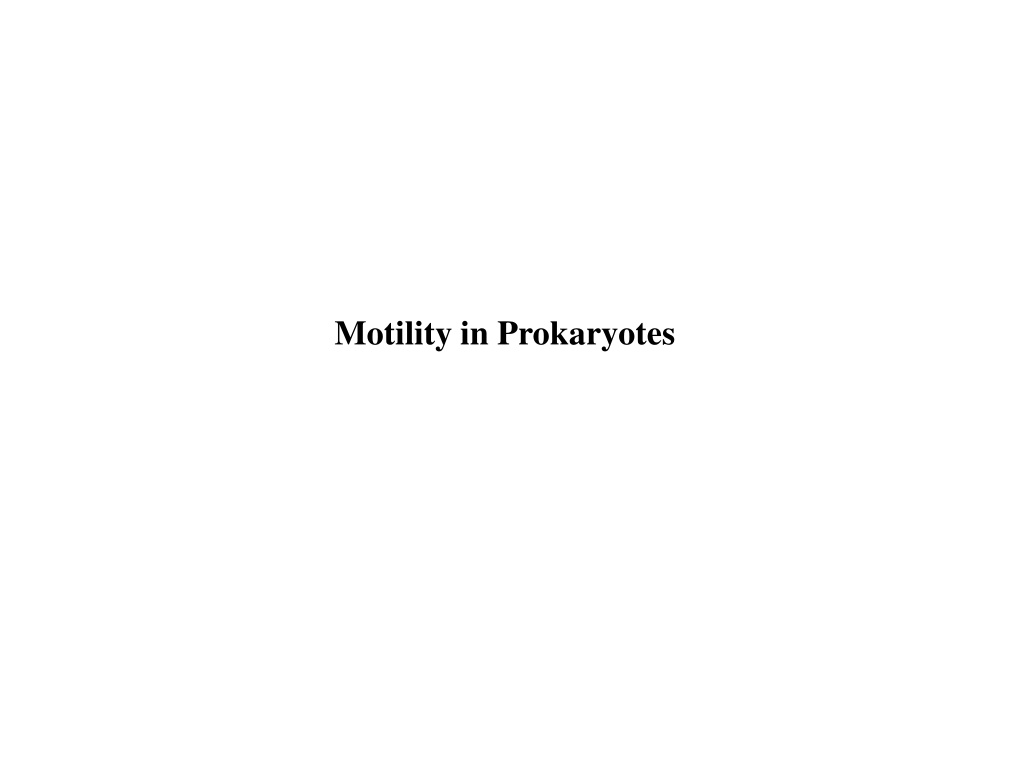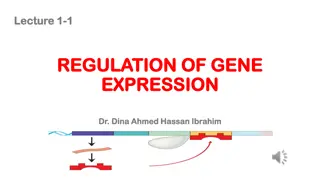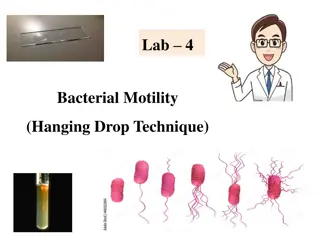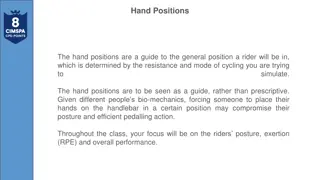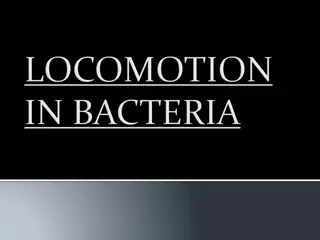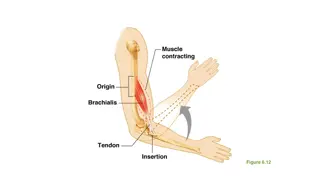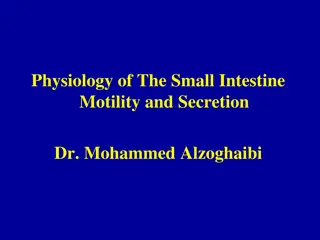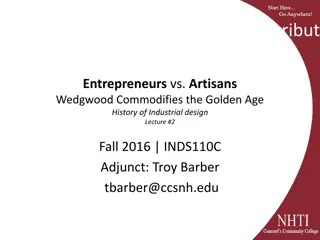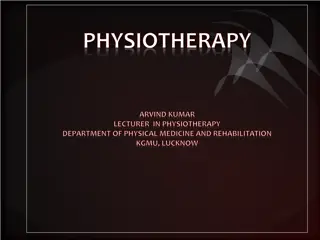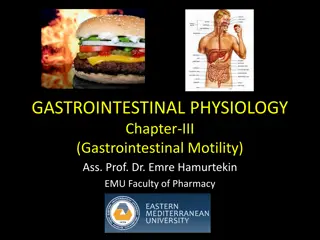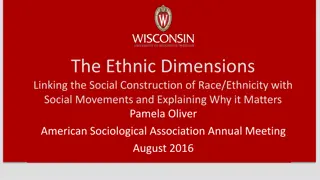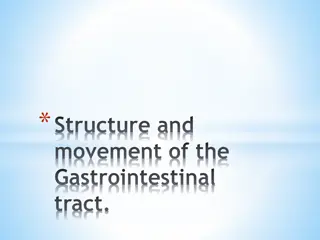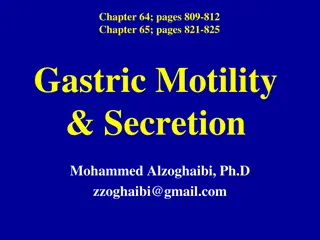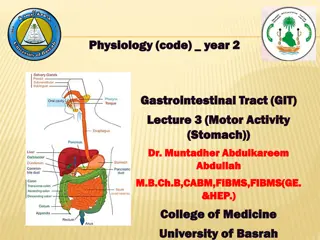Exploring Motility in Prokaryotes: Flagellar, Spirochaetial, and Gliding Movements
Delve into the fascinating world of bacterial motility through three types of movements in prokaryotes: flagellar movement driven by rotating flagella, spirochaetial movement with flexible axial fibrils, and gliding movement observed in certain bacteria on solid surfaces. Additionally, discover how chemotaxis guides bacterial movement towards nutrients and away from harmful substances.
Download Presentation

Please find below an Image/Link to download the presentation.
The content on the website is provided AS IS for your information and personal use only. It may not be sold, licensed, or shared on other websites without obtaining consent from the author. Download presentation by click this link. If you encounter any issues during the download, it is possible that the publisher has removed the file from their server.
E N D
Presentation Transcript
There are three types of movement in bacteria. (a) Flagellar movement: Bacterial flagella are motile and help in locomotion of bacterial cells. Prokaryotic flagellum is semi rigid, helical rotor that moves the cell by rotating from the basal body either clockwise or counter clockwise around its axis. The helical waves are generated from the base to the tip of flagellum. The rotating flagellum forms a bundle that pushes against water and propels the bacterium. The basal body acts as motor and causes rotation. Berg (1975) suggested that a turning motion is generated between S-ring and M- ring, where the former acts as a starter and the later acts as rotor. The P-rings and L-ring are just bashings. The basal body gives a universal joint to the cell and allows complete rotation of the hook and shaft both clockwise and counter clock-wise. The flagella function as a propeller of a boat. The polar flagellum rotates anticlockwise but the cell rotates clockwise when moving normally. Rotation of flagellum in anticlockwise direction results in movement of bacterial cell in opposite direction.
(b) Spirochaetial movement: The spirochaetes show several types of movements such as flexing, spining, free swimming and creeping as they are flexible and helical bacteria lack flagella. Just within the cell envelope they have flagella like structure which are known as periplasmic flagella or axial fibrils or endo-flagella. Axial fibrils are present in the space between inner and outer membrane of cell envelope. The mechanism of motility is not known. Berg (1975) postulated that the axial fibrils rotate in periplasmic space and cause the rotation of periplasmic cylinder on the body axis in the opposite direction.
(c) Gliding movement: Some bacteria such as the species of Cyanobacteria (e.g. Cytophaga) and Mycoplasma show gliding movement when come in contact with a solid surface. However, no organelles are associated with the movement. In the members of cytophagales and cyanobacteria, movement helps to find out the substratum e.g. wood, bark, shell, etc. for anchorage and reproduction. They secrete slime with the help of which they get attached to the substratum. In Oscillatoria princeps fibrils of 5- 8 nm thick are present near the cell surface and located helically around the cell. Oscillation is observed in this alga.
Chemotaxis: Chemotaxis is the movement of bacteria towards chemical attraction and away from chemical repellants. Bacteria are attracted towards the nutrients such as sugars and amino acids, and are repelled by harmful substances and bacterial wastes. They also respond to other environmental fluctuations such as temperature, light, gravity, etc. Bacteria run in a straight direction or slightly curved line for a few second. Then it stops and tumbles for a short while. The tumble is followed by a run in different directions. If the attractant concentration is higher, tumbling behaviour is checked and they run for a long time. The opposite response occurs when a repellent is present.
Positive chemotaxis occurs if the movement is toward a higher concentration of the chemical. Conversely, negative chemotaxis occurs if the movement is in the opposite direction. Chemoattractants and chemorepellents are inorganic or organic substances possessing chemotaxis-inducer effect in motile cells. Effects of chemoattractants are elicited via described or hypothetic chemotaxis receptors; the chemoattractant moiety of a ligand is target cell specific and concentration dependent. Most frequently investigated chemoattractants are formyl peptides and chemokines. Responses to chemorepellents result in axial swimming and they are considered a basic motile phenomena in bacteria. The most frequently investigated chemorepellents are inorganic salts, amino acids and some chemokines.
1. Counter-clockwise rotation aligns the flagella into a single rotating bundle, causing the bacterium to swim in a straight line. 2. Clockwise rotation breaks the flagella bundle apart such that each flagellum points in a different direction, causing the bacterium to tumble in place.
In the presence of a chemical gradient bacteria will chemotax, or direct their overall motion based on the gradient. If the bacterium senses that it is moving in the correct direction (toward attractant/away from repellent), it will keep swimming in a straight line for a longer time before tumbling. If it is moving in the wrong direction, it will tumble sooner and try a new direction at random. The helical nature of the individual flagellar filament is critical for this movement to occur. As such, the protein that makes up the flagellar filament, flagellin, is quite similar among all flagellated bacteria. Many bacteria, such as Vibrio, are monoflagellated and have a single flagellum at one pole of the cell. Their method of chemotaxis is different. Others possess a single flagellum that is kept inside the cell wall. These bacteria move by spinning the whole cell, which is shaped like a corkscrew.
Mechanisms of chemotaxis The special proteins called chemoreceptors are supposed to be present in the periplasmic space of plasma membrane that detects the attractants and repellents. These proteins bind to chemicals and transmit signals to the other components of chemo sensing system. So far about 20 chemoreceptors for attractants and 10 for repellents have been discovered, a few of them take part in the beginning during sugar transport into the cell. E. coli consists of four different chemoreceptors which are often called methyl accepting chemo-taxis proteins (MCPs). MCPs in E.coli include proteins Tar, Tsr, Trg and Tap. Chemoattracttants to Trg include ribose and galactose with phenol as a chemorepellent. Tap and Tsr recognize dipeptides and serine as chemoattractants, respectively These four MCPs are localised in patches often at the end of rod-shaped cells. The MCPs act through a series of proteins. The whole responses triggered within 200 mili second.
The MCPs are embedded in plasma membrane in such a way that their major parts are exposed on the both sides i.e. periplasmic side and cytoplasmic side. The periplasmic side consists of a binding site for attractants and repellents. The attractants either directly bind to MCPs or first bind to special periplasmic binding proteins and then to MCP. The cytoplasmic portion of MCP molecules usually contain about 4-5 methylation sites containing special glutamic acid residues. Methyl groups can be added to these glutamic acids carboxyl group by using S- adenosine methionine as the methylating agent. The chemoreceptor proteins associated with chemotactic responses are CheW, CheA. CheB, CheY and CheZ. The cytoplasmic side of MCP binds with two chemoreceptor proteins. First it binds to two molecules of CheW proteins which attach to a CheA protein resulting in formation of a full complex (an MCP dimer, two CheW monomer and a CheA dimer). Chemoattractants or chemorepellents bind MCPs at its extracellular domain; an intracellular signaling domain relays the changes in concentration of these chemotactic ligands to downstream proteins like that of CheA which then relays this signal to flagellar motors via phosphorylated CheY (CheY-P). CheY-P can then control flagellar rotation influencing the direction of cell motility.
The chemotactic response arises from a combination of: (i) The control of CheA phosphorylation by the concentration of attractants/repellent, (ii) The clockwise rotation promoted by CheY, and (iii) A feed back regulation circuit. CheA is stimulated by the MCP, when unbound to an attractant, to phosphorylate itself by using ATP through the process of auto- phosphorylation. Auto-phosphorylation does not occur when attractant binds to MCP. Phosphorylated CheA provides its phosphate to either CheY or CheB protein receptor. If CheY is phosphorylated it migrates to flagellum, interacts with base protein and results in movement of flagellum clockwise (CW). However, when the concentration of attractant decreases, it results in clockwise rotation and tumbling. The CheZ protein removes the phosphate from CheY in about 10 seconds; when the attractant level changes the bacterium cannot remain in tumbling stage for a long time.
In the absence of attractant or repellent the system maintains the intermediate concentrations of CheA phosphate and CheY phosphate. Consequently a normal run- tumble swimming state is maintained. The responses are shown very quickly. This has a short term memory i.e. for a few second of previous attractant/repellent concentration. This adaptation is accomplished by methylation of MCP receptors. Receptor regulation Irrespective of the concentration of attractants, methylation reaction is catalysed by the CheR protein. The phosphorylated CheB protein (a methyl esterase) hydrolytically removes the methyl group from MCPs. The MCP-attractant complex is a good substrate for CheR protein and a poor substrate for CheB. Due to combining of attractant to MCPs the level of CheY phosphate and CheB phosphate decreases and auto-phosphorylation of CheA is inhibited. This causes in counter clockwise (CCW) rotation and run, and lowers methyl esterase activity resulting in an increase in the process of methylation of MCP.
When methylation is increased, it results in alteration in MCP conformation which in turn again maintains the intermediate level of CheA auto phosphorylation. Therefore, CheY phosphate and CheB phosphate come back to its normal form and attain the normal behaviour of run-tumble. When the attractants are removed, the over methylated MCP stimulates CheA auto phosphorylation. This results in the increase in the level of CheY phosphate and CheB phosphate, and in turn tumbling and de-methylation of MCP receptor.
